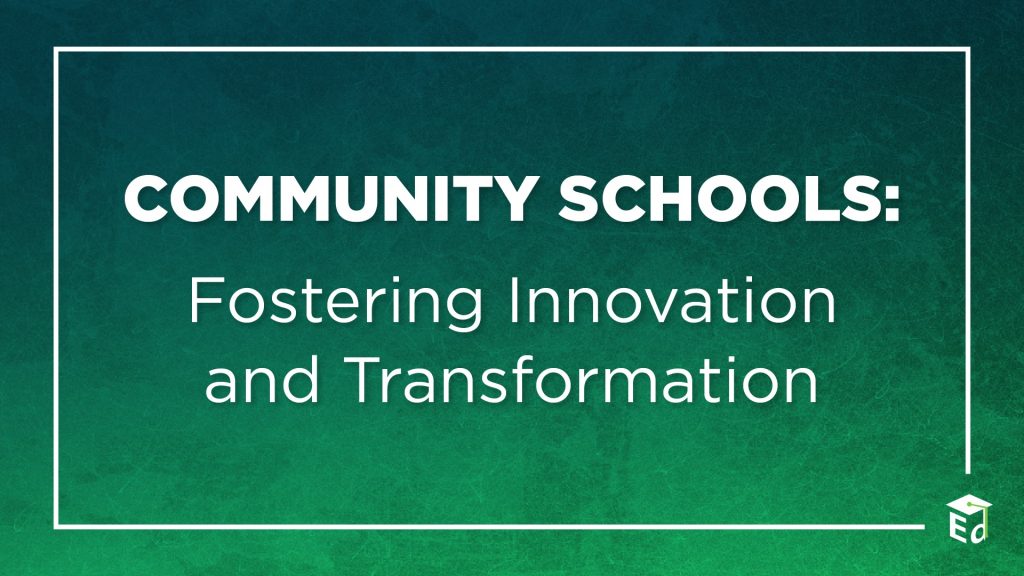
By: David Greenberg & Dr. Linh Dang
The challenges we face in today’s education landscape rarely have simple policy solutions. The youth mental health crisis, insufficient community and family engagement, and lack of access to early childhood learning are only a handful of the complex issues that require innovative strategies that extend beyond the school walls. Thanks to recent investments at the federal and state level, thousands of public schools are transforming into hubs that facilitate community-wide collaboration on these and other challenges by embracing a “community school” framework.
Community schools are not to be confused with traditional neighborhood schools. The community school model provides a mechanism for schools and communities to co-create a plan that addresses the unique priorities and vision of the local community. In many places, this means connecting classroom instruction to local issues to provide a real-world learning experience for students. Community schools develop strategic partnerships to support a range of services, like early childhood education, mental health support, academic tutoring, before and after school programming, mentorship, healthy meals and more to support students and communities from cradle to career. Community schools create the space for families, students, and community members to have a voice in decision-making, recognizing that education is a shared responsibility.
Evidence Based Success
Research shows a strong evidence base for community schools, including a RAND study conducted in New York City which demonstrated improved attendance and student achievement. An Albuquerque study shows a $7 Return on Investment for every $1 invested in a full-time community school coordinator salary. The research on community schools will continue to grow and strengthen practice as the model proliferates. Individual states have invested billions to expand community schools. At the federal level, the Full-Service Community School Grant Program (FSCS) awarded its highest number of awards last year, providing 42 schools, districts, local consortiums, and states with funding to expand the community school strategy to reach more students, families, and neighborhoods. This year, the federal government has allocated $150 million – the highest amount on record – to continue to grow the impact and reach more students.
A Closer Look at Community Schools
Stories of the community school strategy transforming public education are numerous and growing across a range of contexts, from rural and urban settings, elementary and secondary levels, and from statewide to local implementation.
In Kentucky, federal community school grant funds are expanding the state’s Family Resource and Youth Service Centers (FRYSCs). This innovative model is one of the nation’s largest school-based family support initiatives. FRYSCs are located at over 800 school sites in Kentucky where they help to remove barriers to student learning as well as support after-school care, family education, literacy services, and health referrals. The model has contributed to Kentucky having one of the smallest gaps between low-income students and the general student population in the country.
Meanwhile, in Alaska, FSCS funding is helping bring four Southeastern Alaskan school districts together with tribes, private sector entities, and nonprofit organizations to implement comprehensive systems that strengthen student and family cultural identity and support Social Emotional Learning in and out of classrooms. In other places around the country, FSCS grants are expanding community schools in middle and high schools so that students who benefitted in elementary school, like at Enos Garcia Elementary School in Taos, New Mexico, can continue experiencing the benefits as they transition schools.
Current Funding Opportunities
Schools, LEAs, and communities that are interested in the community school strategy have multiple paths available for funding. The Federal Fiscal Year 2023 Full-Service Community School Competition, which is providing $73.8 million in new funding for community schools across the country, was launched on June 7. Potential grantees will have until August 8th to submit an application. Details on the grant competition, along with webinars to support applicants, can be found here on the Full-Service Community School Grant Competition’s website.
In addition to the federal grant program, LEAs and schools can leverage a range of Title funds and pandemic relief funds to launch community schools, and this past January the White House released a toolkit to help leverage a variety of federal resources for the development and sustainability of community schools. The Community Schools Forward Task Force has also produced a tool to help with budgeting.
At a time when our national challenges seem so complex, the road ahead for public education seems clear – let’s more deeply invest in the wisdom of local communities through proven frameworks like community schools. The first step is to bring together a team of students, staff, families and community members to learn more about the community school strategy.
David Greenberg is a Senior Policy Analyst at the National Education Association focusing on community school implementation. He co-leads the NEA Community School Implementation Institute and is a co-lead for the California Community Schools State Transformational Assistance Center, and formerly served as the Executive Director for the NEA-New Mexico Center for Community Schools.
Dr. Linh Dang is a Senior Policy Specialist within the Education Policy and Implementation Center at the National Education Association. Her portfolio covers policies and programs relating to a wide-range of public school options. She was previously an adjunct professor of education research, state legislative staffer, and a teacher leader in the San Francisco Unified School District.

